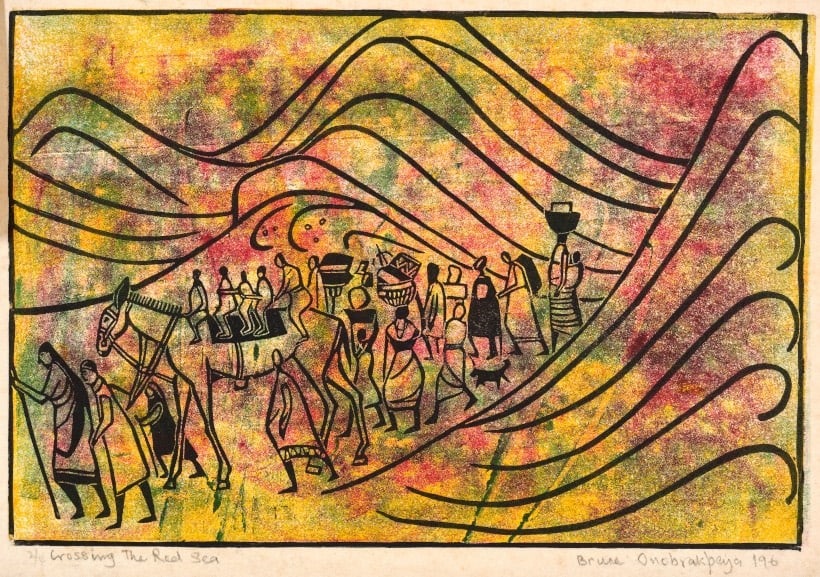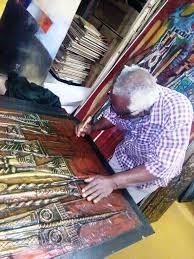Bruce Onobrakpeya, born with the full name Bruce Obomeyoma Onobrakpeya, is a versatile Nigerian artist renowned for his mastery in printmaking, painting, and sculpting. His birth on August 30, 1932, marked the emergence of a creative force that would make a lasting impact on the art world, especially in West Africa.
Considered one of the most accomplished artists to emerge from the region in the 20th century, Onobrakpeya’s influence extends far beyond his own creations. He has played a pivotal role in shaping the artistic landscape of Nigeria, particularly for artists who matured in the post-colonial era. Through his innovative techniques and steadfast commitment to African tradition and philosophy, Onobrakpeya has paved the way for a new generation of artists to explore and celebrate their cultural heritage through art.
Onobrakpeya’s work is characterized by a profound respect for his cultural background. Through his art, the rich tapestry of Nigerian mythology, spirituality, and folklore is preserved and celebrated. Onobrakpeya revitalizes ancient stories and rites, infusing them with new life and relevance through his trademark printmaking techniques, such as relief printing, engraving, and etching. His mastery of form and texture, coupled with a vibrant color palette, creates visual narratives that captivate viewers’ senses and intellect alike.
As one of Nigeria’s esteemed artistic pioneers, Onobrakpeya presents a collection of 36 rare prints that offer a retrospective journey through his prolific career. Growing up in Delta State, Nigeria, Onobrakpeya’s artistic journey began to flourish when he obtained a Diploma in Fine Arts and a Teacher’s Certificate from what is now known as Ahmadu Bello University in Zaria in 1962.

His involvement as a founding member of the Zaria Art Society was instrumental in shaping his artistic philosophy. Alongside fellow luminaries such as Uche Okeke, Yusuf Grillo, and Demas Nwoko, Onobrakpeya spearheaded a movement that sought to redefine artistic expression by reconnecting it with African cultural roots. This collective, often referred to as the “Zaria Rebels,” challenged the dominance of Western artistic techniques and ideologies, advocating for an approach deeply rooted in African heritage.
Onobrakpeya’s artistic ethos transcended mere rebellion; it was a quest for authenticity and cultural resonance. Through his experimentation with various media, he embarked on a journey to capture the essence of Nigeria’s rich history, culture, and socio-political landscape. His paintings, sculptures, prints, and installations serve as poignant reflections of the nation’s evolution, chronicling its triumphs and tribulations with profound insight and sensitivity.
“We were not rebelling against anything as such,” Onobrakpeya remarked, reflecting on the Zaria Art Society’s ethos. “But thought that the idea of just using the Western art technique without relating it to our culture wasn’t right.” His artistic endeavors, therefore, became a bridge between tradition and modernity, weaving together the threads of Nigeria’s past and present to create a vibrant tapestry of artistic expression. Through his work, Onobrakpeya continues to inspire generations of artists to embrace their cultural heritage and forge their own artistic identities rooted in authenticity and reverence for the African experience.
Bruce Onobrakpeya has garnered numerous accolades throughout his illustrious career. His works have been showcased in prestigious venues worldwide, including the Venice Biennale in 1990, the Tate Modern in London, the National Museum of African Art at the Smithsonian Institution in Washington, D.C., the Malmö Konsthall in Sweden, and the National Gallery of Modern Art in Lagos, among others. In recognition of his contributions to art and culture, he was honored with the UNESCO Living Human Treasures Award in 2006.
Onobrakpeya’s innovative techniques have set him apart in the art world. Among his notable methods are bronzed line relief, plastocast (resin) relief, plastograph, and metal foil etching and relief print. His versatility extends beyond printmaking and sculpture to include painting and drawing. In recent years, he has produced vibrant serigraphs from his “Sunshine period,” characterized by the use of bright colors and a depiction of tropical radiance, which have become signature elements of his art.

Beyond his practical art, Onobrakpeya has developed a unique writing style he calls Ibiebe. This script features ideographic, geometric, and curvilinear glyphs inspired by his Urhobo heritage, rich with symbols and proverbs. Through Ibiebe, he expresses his deep connection to his cultural roots, blending communication and preservation in a truly modern manner.
Onobrakpeya’s distinctive approach to art, heavily influenced by West African philosophy, history, and decorative arts, has earned him a formidable reputation over the decades. His contributions to Nigerian Modernism are widely recognized and celebrated, particularly highlighted in his current retrospective at the High Museum of Art in Atlanta, titled “Bruce Onobrakpeya: The Mask and the Cross.” This exhibition provides a comprehensive examination of his oeuvre and his impact on the art world, solidifying his status as a pioneering and influential artist.
Bruce Onobrakpeya is a survivor and a beacon of hope in a world full of uncertainty and rapid change. He never fails to astonish audiences with his imaginative vision and unwavering dedication to his craft, prompting them to embark on a journey of self-discovery and reflection. As a cultural ambassador of Nigeria, Onobrakpeya will leave a lasting legacy that will inspire future generations and serve as a reminder of art’s ability to transcend national boundaries, bringing people together through mutual respect and understanding.
Sources




